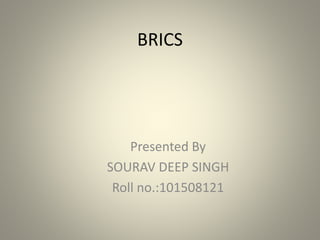BRICS
- 1. BRICS Presented By SOURAV DEEP SINGH Roll no.:101508121
- 2. CONTENTS • INTRODUCTION • HISTORY • SUMMITS • ABOUT BRICS FORUM • CHALLENGES • ADVANTAGES • DISADVANTAGES • CONCLUSION
- 3. ABOUT BRICS • BRICS is the acronym for Brazil, Russia, India, China and South Africa. • It is an association of five major emerging national economies. • They are distinguished by their large, fast growing economies and significant influence on regional and global affairs • The five BRICS countries represent over 3.6 billion people, or half of the world population. • The five nations have a combined GDP of US$16.6 trillion. • Bilateral relations conducted on the basis of non- interference, equality, and mutual benefit.
- 4. HISTORY • The term "BRIC" was coined in 2001. • It was coined by the then-chairman of Goldman Sachs Asset Management, Jim O'Neill. • The foreign ministers of the initial four BRIC states met in New York City in September 2006. • A full-scale diplomatic meeting was held in Yekaterinburg, Russia, on 16 June 2009.
- 5. FIRST BRIC SUMMIT • The first formal summit was held in Yekaterinburg on 16 June 2009. • The summit's focus was on improving the global economic situation and reforming financial institutions. • Discussed how the four countries could better co-operate in the future. • The BRIC nations announced the need for a new global reserve currency.
- 6. ENTERY OF SOUTH AFRICA • South Africa became a member nation on 24 December 2010. • The group was renamed BRICS. • In April 2011, the President of South Africa, Jacob Zuma, attended the 2011 BRICS summit in Sanya, China, as a full member.
- 7. SUMMITS Summit Date Venue 1st 16-Jun-09 Yekaterinburg, Russia 2nd 15-Apr-10 Brasilia, Brazil 3rd 14-Apr-11 Sanya, China 4th 29-Mar-12 New Delhi, India 5th 26-27 Mar-13 Durban, South Africa 6th 14-16July-14 Fortaleza, Brazil 7th 8–9 July-15 Ufa, Russia 8th 15–16 OcT-16 Goa, India 9th 2017 Xiamen, China
- 8. ABOUT BRICS FORUM • Formed in 2011. • It is an independent international organization that works for a structured social, economic and environmentally sustainable BRICS block. • Currently the forum is working on building partnerships and collaborating with member state institutions.
- 9. FOCUS OF BRICS FORUM • To develop a development bank to balance the influence of the World Bank and IMF • Business • Governance and leadership • Science and technology • Poverty • Investment landscape • To remove trade barriers • Healthcare • Innovation in building infrastructure
- 10. BRICS GROWTH
- 11. FINANCIAL STRUCTURE NEW DEVELOPMENT BANK • Treaty was signed in 2014 and became active in 2015. • It is a multilateral development bank operated by the BRICS states. • Its focus will be on lending of up to $34 billion annually for infrastructure projects. • The bank will have starting capital of $50 billion, with capital increased to $100 billion over time. • The bank is headquartered in Shanghai, China. • K. V. Kamath was appointed as the President of the bank
- 12. Why BRICS need NDB? • Growing emerging market. • International economic growth. • Financial assistant. • Populations control. • Climate change, food and energy security.
- 13. CHALLANGES • Development of BRICS bank. • Reduce the urban-rural income gap. • Maintaining macroeconomic stability. • Inadequate financial reform. • Managing supply chain. • Addressing gender inequalities. • To remove trade barriers. • Optimum use of resources. • To achieve regional development. • Building relationship.
- 14. ADVANTAGES • Large population provides a large work force. • Block foreign terrorists and blocking sources of financing terrorism. • Increase trade between the BRICS nations. • Establishment independent financial institution. • Rapid expansion of the middle class will boost the economy. • Less dependent on exports. • Extremely rich in resources such as coffee, sugarcane, iron and crude oil etc.
- 15. DISADVANTAGES • Population problem. • Lack of infrastructure. • Decline in economy and population in Russia. • On going conflicts with the neighboring countries. • Corruption.
- 16. TARGET SECTOR FOR BRICS TRADE • Manufacturing, services and agriculture. • Construction and water provision. • The green economy and tourism. • Energy, infrastructure, mining beneficiation. • Increase healthcare.
- 17. CONCLUSION • The BRICS have come together in a political grouping in a way that has far exceeded most expectations. • Although BRICS cooperation has been significant , intra –BRICS competition and rivalry are important limits on how much further BRICS cooperation can go.
- 18. THE END

















